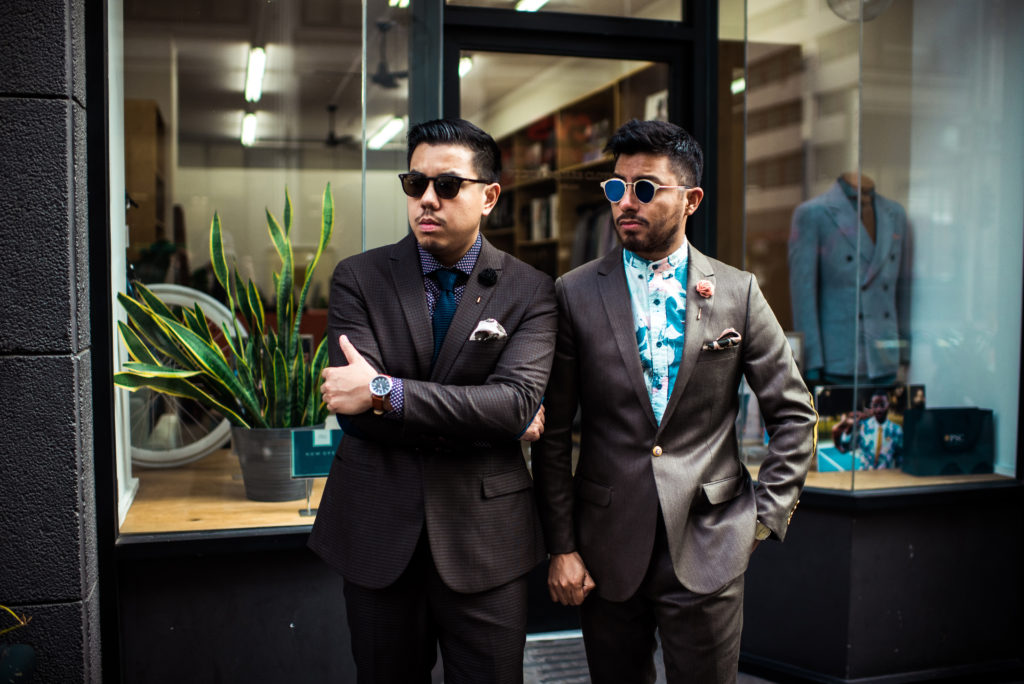We recently had the honor of sitting down with Pocket Square Clothing (PSC) to learn about what it takes to start and maintain a successful brand in today’s digital market.
What’s the story behind the beginnings of PSC?
Rodolfo Ramirez: Pocket Square Clothing was established in 2011 as a men’s accessory brand. With no formal fashion training, but with an architectural and business background from USC, we sought to create a lifestyle brand beyond clothing. Starting the brand was our response to what we saw in the market as 21 year-old college students looking to upgrade our sense of style. We primarily focused on finding interesting textiles and adopted floral prints as our brand staple since conception.
To date, we feature a collection of handcrafted bow ties, skinny neckties, pocket squares, and custom suits and shirts. The brand is a reflection of the ideals behind the “Urban Gentleman”. PSC is our effort to tell a story, to inspire and be inspired, and to create a powerful connection with people through timeless pieces.
We spent 5 years in the the direct-to-consumer and wholesale business before taking the leap and opening a brick and mortar. PSC’s previous retail experience centered around weekend pop-up shops and short 1-3 month pop-up stores at the Grove, Liberty Fairs Concept Space, and Matteo in the Arts District in Los Angeles.
What was your best and worst experience with PSC?
RR: Constant learning, traveling and meeting other creatives around the world has been at the top of the list for my best experiences with PSC. As a culturally diverse brand, many doors and opportunities have been opened for collaboration and community building.
No one likes to lose money on investments made. Our very first pop-up event was miserable; two days were spent and only a hand full of bow ties were sold. I was ready to quit and move back into architecture. This pop-up happened at the 1 month mark of our brand, we persisted and we proved that the business could actually be successful. Had I quit because of our first failed attempt, all of those great PSC experiences would not have been possible.
Andrew Cheung: Our first official retail experience was running our pop-up at The Grove in LA. Hiring and managing employees at the retail level was extremely challenging while trying to run our brand at the same time. Not only that, we were under strict guidelines with management at the Grove and given tough limitations as to what we could or could not do. To say the least, I try not to think about that time.
With that said, our pop-ups were incredible learning experiences that led to us opening our PSC Flagship retail store last year. It’s been an amazing year. We reached our milestone goal to open our first flagship store by year 5 of our brand, we’ve been voted the best menswear boutique in DTLA, and most important of all, we have a physical base we can call our own and share that with the local community and our customers who come from all over the world.
How would you describe each other as business partners and as friends in three words?
RR:
Business partner: Trustworthy, Resourceful, Persistent
Friend: Clever, Witty, Frank
AC:
Business partner: Accountable, Creative, Balance
Friend: Multifaceted, Gravitational, Synced
What are four things we can look forward to seeing from the PSC brand?
RR: We are working on a bag collection and looking to expand into custom women’s suiting. Our expansion into women’s suiting is our effort to widen our market and offer our women contingency PSC tailored and designed garments. Ready to wear suiting and shirting are in the process of being designed and is expected to be released spring of 2018.

What are five tips you would give to others wanting to follow in your footsteps?
RR:
- Be Humble. Learn what your weaknesses are and work on them.
- Ask questions. Ask you customer, colleagues and manufacturers as many questions as you can think of.
- Build with your peers. Find a group of people that you can build with. A path traveled alone is hard and not that fun.
- Find your customer. Get to know who your customer base is and what they want.
- Be flexible. Adapt to good and bad opportunities. Try something a few times, see if it works. If it doesn’t work, pivot. If it does work, you are on to something.
AC:
- Unless you’re a genius or just plain lucky, find a partner who can fill in the voids and balance you.
- Most brands or businesses in general are not overnight successes, and most even fail.
- Stay the course and be consistent. Set goals and make sure you meet those milestones. Your customers are the key to your success so pay attention. Also, don’t be stupid.
- Be resourceful; you don’t need a million dollars to design a collection or product. Don’t be afraid to ask for help or ask questions. You’re more likely to be helped than rejected unless you’re just an awful person.
- Be engaged. You are the brand, so put yourself out there. Don’t be all talk, put your money where your mouth is. Constantly create and learn. Don’t be afraid to question, analyze, communicate, experiment, and reinvent. Complacency is your enemy, and sometimes you are your own.
- You’re not special. But you certainly can make people think you are. Focus on what makes you different and study what your core audience relates to. Build a brand people can rally behind.
By XOMAD team members @franciskenneth and Darby Barton
#InfluencerMarketing #teamXOMAD #InfluencerLed
Images via Allen Daniel Photo
Check out our last interview with Ocean Spray here!

